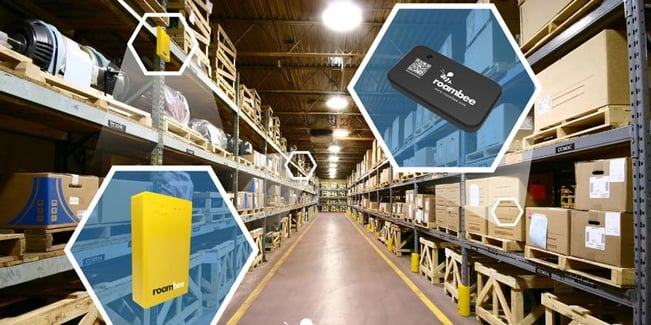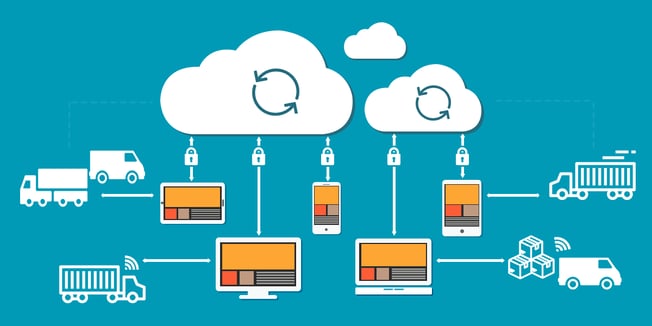GPS vehicle tracking systems have been unsuccessful at tracking Less-than Container Load (LCL) goods, individual packages, and shipments moving on “by-trip” market hired vehicles aka market vehicles. In this article, you will learn how you can track these types of cargo loads using a hybrid IoT solution.
Tracking full-truck-loads (FTLs) on surface may seem easy! You can plug a vehicle tracker to your vehicle and track its movement in real-time. By doing so, you get real-time visibility into the location of your goods.
Getting a grip on LCL Cargo, on the other hand, can be quite challenging because:
- You are not sure which truck your cargo is moving on.
- It could be moving across multiple modes of transport such as air, rail, sea, and surface.
- Most existing logistics tracking solutions are vehicle or fleet based, they do not track individual packages or pallets.
About $26.5 billion of freight is spent on shipping LCL/LTL cargo in the US alone[1], so it is definitely a big problem in terms of scale!
What is a LCL/LTL Shipment?
A Less-than-Truck-Load (LTL) or Less-than-Container-Load (LCL) shipment is one where you don’t hire the entire truck to transport your goods. You are simply renting out space on a truck or booking a parcel/container/trailer which could travel across multiple trucks, as well as others modes of transport, before it makes it to the final destination.
Tracking the truck doesn’t always help provide logistics control, even with Full Truck Loads (FTLs), because:
- Your cargo is still prone to pilferage (where a few parcels are lifted off the truck)
- You have no insight into the condition of temperature sensitive or fragile goods
- Implementing a fleet management system is a vehicle-supplier initiative — you are seldom in the driving seat of such an initiative.
Also, when you are using market vehicles hired on a “per-trip” basis, you cannot install GPS vehicle trackers on-demand.
What is a Market Vehicle?
A market vehicle is full-truck-load (FTL) hired on a “by-trip” basis. The shipper doesn’t know whether or not there is a GPS vehicle tracker installed on that truck for visibility.
The concept of LCLs, LTLs, and Market Vehicles was developed to improve shipping efficiencies by preventing trailers from returning empty after delivery (deadheading).
See why the vehicle tracking and fleet management systems have failed for logistics visibility.
That said, how can you get a good handle on your LCL cargo, where it is, and whether it is safe, damaged or stolen?
You need a hybrid Internet of Things (IoT) solution which uses the functionalities of technologies like GPS, GSM, Wi-Fi, and Bluetooth Low Energy (BLE) technologies to make you see and feel your LTL cargo or packages virtually through their journey.
Setting Up Hybrid IoT Solution to Track LCL
A successful IoT solution has a few essential components to help you successfully get real-time visibility and actionable data about your shipments.
- A Portable GPS/GSM/BLE/Wi-Fi Enabled Gateway Hotspot Device
- BLE Tags or Beacons
- A plan for the Reverse Logistics of these IoT Devices
- Data Analytics
- 24X7 Monitoring
- Ensure Data Backup & Plug Security Gaps
1. Get A Portable GPS/GSM/BLE/Wi-Fi Enabled Gateway Hotspot Device

The type of devices that help you monitor LCL cargo are portable in nature so they can ride with your shipment, and are not just restricted to your truck. The technology is not very different from a mobile phone, but the device must be able to conserve battery to last throughout the shipment, and have the right set of sensors such as temperature, pressure, humidity, shock, etc. to provide you with insights into your shipment’s health.
Such a portable gateway hotspot device (like the “”) is slightly different from standard GPS vehicle tracking solutions in the sense that it must support AGPS, cellular triangulation, and telco based locating services to get a valid location when there is no GPS fix.
Why do you need cellular triangulation as backup?
GPS signals are low inside a trailer or container, due to attenuation and also partly due to the formation of what is referred to as a “Faraday’s cage” in Physics. This is especially true when dealing with metal containers or refers where the walls are thick, and no GPS fix means no location.
During the absence of GPS signal, the gateway hotspot device needs to find its location through cellular triangulation. It is the process of using the cellular towers in its vicinity to identify where it is.
When do you need a Telco LBS based location lookup?
When you have very low network. Imagine the shipment is on a rural highway and there is only one bar of signal, which too is fluctuating, it is not enough for the device to send out data packets.
This situation is quite similar when you have very low signal (just a bar) and you are trying to send that critical message through WhatsApp to wish your friend on her birthday night, but doesn’t go through! In such situations, your device is still connected to a cell site but the signal isn’t strong enough for any significant amount of data transfer.
Since your phone (or the gateway hotspot device in this case) is still connected to a tower, your telecom company (“Telco”) can still look up the location of the tower it is connected to although the signal strength is minimal. This is called Telco Locating Based Service or Telco LBS and is also similar to how the “911 service” in the US tries to locate you during an emergency.
With cellular triangulation and Telco LBS in place to provide you with a valid location when GPS fails, Wi-Fi is also something that comes in handy, but in a situation where your cargo is located inside the warehouse and there is absolutely no cellular connectivity. Therefore, your device needs to have a Wi-Fi port too so it is Always ON.
But, why does your device need a Bluetooth port as well? It is to get your visibility down to a package-level.
2. Get Granular Using BLE Tags/Beacons for your packages

Now that you have got visibility into your LCL load or trailer, it is time to dig deeper.
What if your load consists of 500 boxes and about 10 of them are misplaced during the haul, or worse they are lifted off the truck, or a box is delivered to the wrong location in the case of milk-runs? Tracking your cargo (pallet, container, or trailer) as a single unit doesn’t help!
This is where the Bluetooth port in your gateway hotspot device comes in handy. Your gateway device will senses the BLE beacons placed in these 500 boxes and let you know if they all safe (typically within a 300ft radius) like schoolkids during a picnic.
By embedding sensors for temperature, pressure, humidity, impact, and tilt, into your beacons, you can get granular insight into the location and condition of each and every package in your consignment.
Meet the Bee & the BeeBeacon, the industry’s first in-transit gateway solution for logistics monitoring at a package-level.
The Bee functions as a gateway device to track your cargo while the BeeBeacon is the multi-sensor beacon providing granular visibility into your individual packages in it.
3. Build a Plan for the Reverse Logistics of these IoT Devices
The portable nature of the gateway hotspots and the beacons could have a potential downside. They demand a tight reverse logistics system to be set in place to ensure you keep your costs of implementation low.
You can either have your consignee drop the devices off at an outgoing mail box after use or leverage your courier networks to pick it up from the end destination.
Since your goal of implementing visibility in your logistics in the first place was to reduce your shipping hassles, this reverse logistics activity could accumulate as an additional responsibility for you. Therefore, it is wise to choose an IoT solutions provider who can manage the reverse logistics of the beacons and the gateway devices and offer you the solution as a managed services offering.
Learn how to pick your real-time shipment tracking partner wisely!
4. Nail Down Your Data Analytics for a Trusted Dot on the Map

Why are you getting visibility into your LCL movement? It is so you can run a more optimized supply chain.
Running an optimized logistics operation means that you need to be able to make the right decision at the right time. Many a times, the time you get to respond may not be sufficient to take the right decision.
Have you ever gotten a GPS alert saying your shipment or vehicle has been standing at a particular location for a long period of time and you are not sure why?
Here is where good data analytics can be a differentiator.
To get “trusted” actionable intelligence you need:
- A system that matches device data with external sources - For example, if the traffic conditions indicate that the halt was due to a traffic congestion, it is probably not something you need to worry about, but if the unscheduled halt was in a region prone to thefts , the situation could mean that you need to get up from your seat right away and act!
- A system which studies your past patterns and uses it to determine the future outcome – History lessons could help unfold in the future. Heat-mapping your lanes and understanding reasonable SLAs will help you deliver as per commitment.
- A system which plugs into your ERP/TMS/Enterprise Software – After all, there is no point in missing out on the insights you already have from your enterprise tools, and what is better than clubbing real-time logistics insights with the rest of your enterprise data? Such an integrated system will do more than help you run a better logistics show. It will tell your sales teams when the shipment will arrive, will provide your finance teams real-time visibility into your efficiencies and savings, and improve the overall productivity of your enterprise.
When you look at a real-time logistics tracking IoT solution, remember to study how the platform works, where it sources its external data from, and how it analyses the internal and external data streams to provide you with trusted actionable intelligence, else, you could be dealing with a lot of false alarms that can potentially disrupt your work schedules.
5. Setup a Control Tower Operation

When a patient is having a stroke or a heart-attack, the time taken to reach the Emergency Room (ER) could determine a life or death outcome. It is no different with your LCL or FTL cargo. If a box of vaccines are heating up or your ice-cream is melting, prompt action can save them.
Does this mean that you have to drop everything you are doing and attend to your shipment every time there is an anomaly? What if such anomalies occur every day, many times a day?
Therefore, you need a dedicated team to look into your logistics operations round the clock and remotely act to minimize the threats to your shipment in the chain of custody.
Since this is an expensive proposition for most enterprises, many 3PLs and logistics companies offer such control tower services along with their core freight service, but control tower services offered by 3PLs are seldom effective without real-time data and good analytics in place.
You need to know when to call “whom” in the chain of custody, and “what” specific problem to solve so your enterprise supply chain is up and running 24x7.
6. Ensure Data Backup & Plug Security Gaps

With increased transparency comes increased threats!
Your LTL shipments and packages are not just being tracked, this valuable data is sitting on a cloud, which if accessed by trouble-makers, could mean disaster for your logistics and enterprise operations.
For instance, if you are a pharma company, a single incidence of theft could mean months of efforts in tracing down the blacklisted products at the point of sale, and several other liabilities.
Read about what goes into digitizing your pharma supply chain, when done right!
Hence, it is important to plug security gaps in your system starting from the hotspot firmware to the beacon protocols to the platform and cloud that you are using.
Data backup is as important as data security because you never know when you need your old data trails. Many years after a shipment was delivered, you might need data to prove that you transported your goods in the safest possible manner to your customer or the law enforcement.
Ensure that your systems comply with global or country specific data mandates such as the 21CFR Part 11 compliance.
Why RFID Based Parcel Tracking Systems Didn’t Work Out
RFID tags and readers look similar to the type of hybrid GPS/GSM/BLE/Wi-Fi gateway hotspots and beacons but they have some major disadvantages:
1. RFID needs infrastructure – A Wi-Fi or LAN connection, so it doesn’t work great for in-transit logistics.
2. Active RFID, the most suited type of RFID for package-level tracking, is proprietary and hasn’t reached economies of scale like GSM and BLE beacon technology has, and thus is expensive.
3. Battery life of RFID readers are hard to extend for long-haul shipment as compared to Bluetooth Low Energy (BLE) which works on a certain frequency and method of transmission that optimizes power when compared to RF waves.
Learn why RFID is outdated when it comes to logistics and supply chain visibility.
Getting Started With Package Tracking Using IoT
To get started with getting the right solution for your cargo tracking requirements, download this guide and understand the key components of a good hybrid IoT real-time shipment tracking technology.
Build an RFP, invite the right kind of vendors to the table, and get started today!
References
1. http://cerasis.com/2015/03/17/shipping-ltl/














